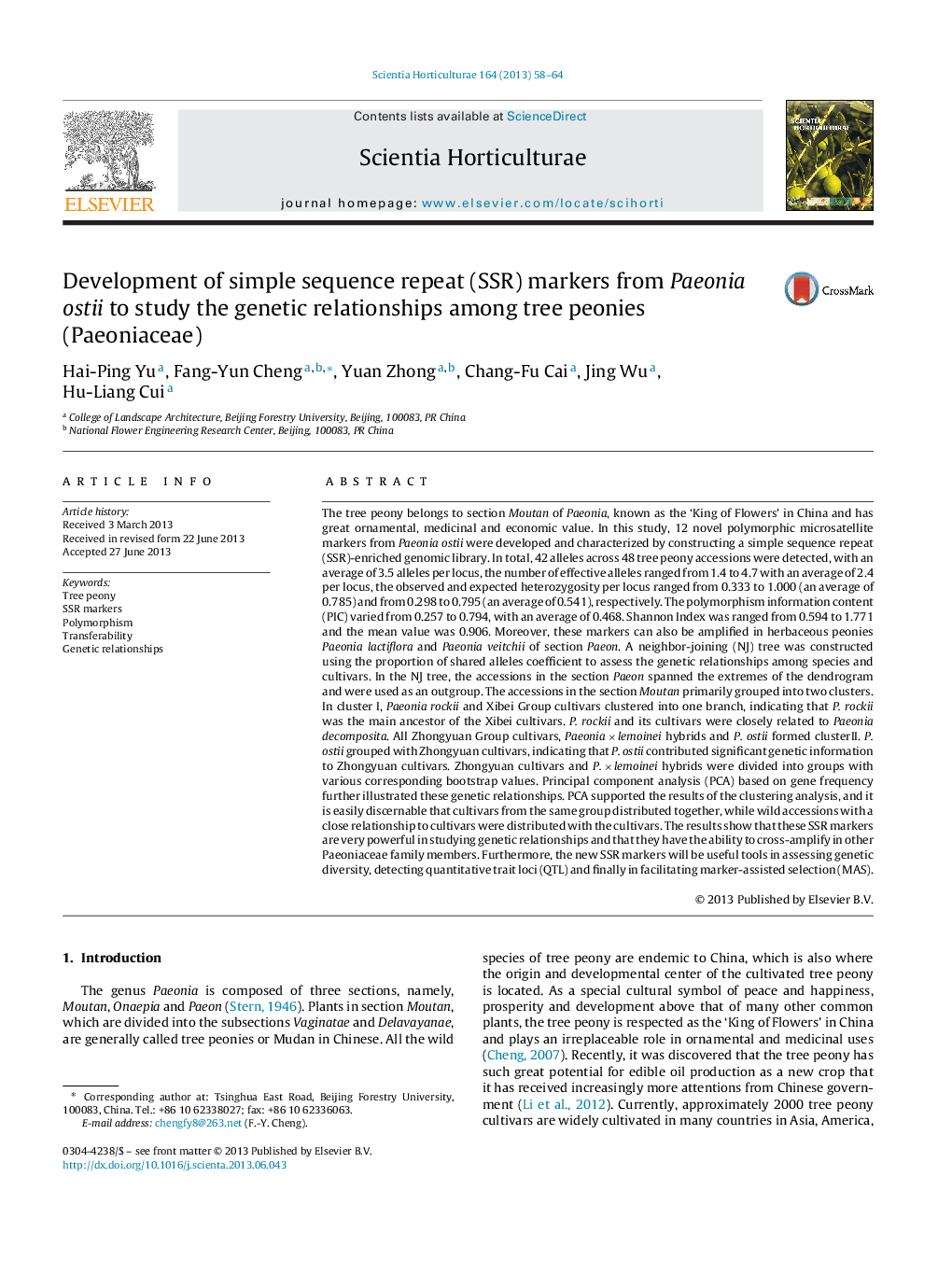| کد مقاله | کد نشریه | سال انتشار | مقاله انگلیسی | نسخه تمام متن |
|---|---|---|---|---|
| 4567041 | 1628834 | 2013 | 7 صفحه PDF | دانلود رایگان |

• This is the first attempt to use Paeonia ostii as materials to develop SSR markers in Paeonia.
• We developed 12 novel polymorphic SSR markers in tree peonies and test their cross-amplification in two herbaceous peony species (Paeonia veitchii and Paeonia lactiflora).
• Genetic relationships among 53 accessions, including 8 species and 40 cultivars of tree peonies and 5 accessions of herbaceous species/cultivars, were studied based on the 12 polymorphic SSR markers.
The tree peony belongs to section Moutan of Paeonia, known as the ‘King of Flowers’ in China and has great ornamental, medicinal and economic value. In this study, 12 novel polymorphic microsatellite markers from Paeonia ostii were developed and characterized by constructing a simple sequence repeat (SSR)-enriched genomic library. In total, 42 alleles across 48 tree peony accessions were detected, with an average of 3.5 alleles per locus, the number of effective alleles ranged from 1.4 to 4.7 with an average of 2.4 per locus, the observed and expected heterozygosity per locus ranged from 0.333 to 1.000 (an average of 0.785) and from 0.298 to 0.795 (an average of 0.541), respectively. The polymorphism information content (PIC) varied from 0.257 to 0.794, with an average of 0.468. Shannon Index was ranged from 0.594 to 1.771 and the mean value was 0.906. Moreover, these markers can also be amplified in herbaceous peonies Paeonia lactiflora and Paeonia veitchii of section Paeon. A neighbor-joining (NJ) tree was constructed using the proportion of shared alleles coefficient to assess the genetic relationships among species and cultivars. In the NJ tree, the accessions in the section Paeon spanned the extremes of the dendrogram and were used as an outgroup. The accessions in the section Moutan primarily grouped into two clusters. In cluster I, Paeonia rockii and Xibei Group cultivars clustered into one branch, indicating that P. rockii was the main ancestor of the Xibei cultivars. P. rockii and its cultivars were closely related to Paeonia decomposita. All Zhongyuan Group cultivars, Paeonia × lemoinei hybrids and P. ostii formed clusterII. P. ostii grouped with Zhongyuan cultivars, indicating that P. ostii contributed significant genetic information to Zhongyuan cultivars. Zhongyuan cultivars and P. × lemoinei hybrids were divided into groups with various corresponding bootstrap values. Principal component analysis (PCA) based on gene frequency further illustrated these genetic relationships. PCA supported the results of the clustering analysis, and it is easily discernable that cultivars from the same group distributed together, while wild accessions with a close relationship to cultivars were distributed with the cultivars. The results show that these SSR markers are very powerful in studying genetic relationships and that they have the ability to cross-amplify in other Paeoniaceae family members. Furthermore, the new SSR markers will be useful tools in assessing genetic diversity, detecting quantitative trait loci (QTL) and finally in facilitating marker-assisted selection (MAS).
Journal: Scientia Horticulturae - Volume 164, 17 December 2013, Pages 58–64